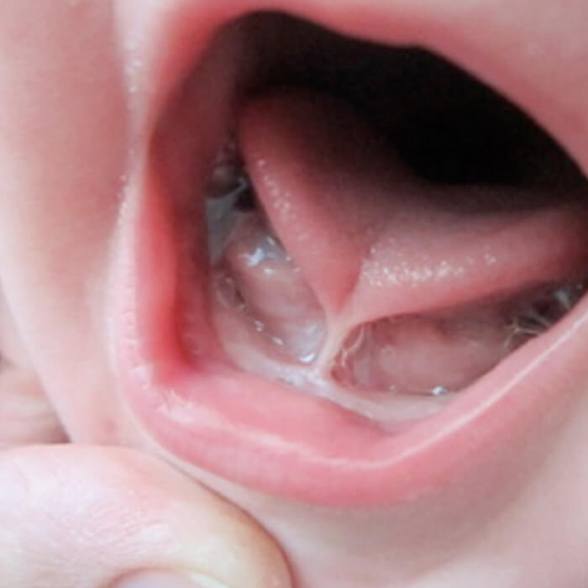Lip & Tongue Tie Treatment – Chesterfield, MO
Releasing Restricted Tissues for Greater Oral Movement
The inability of a baby to use its tongue or lip can create many problems for both you and your little one. Nursing, bottle-feeding, and the bonding time that comes with these practices can be hindered because of a lip or tongue tie. But Dr. Homer Sedighi can change that with the help of frenectomies. As a safe and proven effective method of treatment, he can release the restricted tissues to ensure greater oral movement moving forward. Call our office today if you suspect that your child may be suffering from a lip or tongue tie.

How Do Lip and Tongue Ties Develop?

A lip or tongue tie forms while a baby is still inside the womb. When born, most children experience no issues with the movement of their lip and/or tongue; however, if the band of tissue behind the upper lip or underneath the tongue is too tight, it’s likely to cause problems during infancy.
Some of the most common symptoms associated with a lip or tongue tie include:
- Fussiness
- Poor latch during nursing
- Difficulty keeping a bottle inside their mouth
- Acid reflux and/or colic
- Prolonged feedings, which lead to exhaustion
- Painful breastfeeding
- Clogged milk ducts
- Baby is unable to keep a pacifier in their mouth
- Blocked or clogged milk ducts
Why Is It Important to Treat Lip & Tongue Ties?

There is a high probability that if your little one has a lip or tongue tie, it will be detected and possibly even treated before you leave the hospital with your baby. But if you get home and do not notice the problem until a bit later, you’ll want to schedule an appointment with a pediatric dentist right away.
Refusing to seek treatment early on can put your baby at risk of possible problems now and in the future, such as:
- The inability to breathe freely throughout the night
- Mouth breathing
- The development of a speech impediment (i.e., a lisp)
- Large gap between the upper front two teeth, which can be embarrassing and increase the risk of gum disease
- Have difficulty swallowing certain foods
Lip & Tongue Tie Treatment

Dr. Homer Sedighi believes in providing effective solutions that are not only safe for little smiles but also comfortable.
When a patient arrives claiming that their little one has a lip or tongue tie, he will begin by examining the area in question to determine if the restricted tissue is tight and thick enough to warrant treatment. If so, he will formulate a treatment plan so that you can review it before making a final decision.
If you should decide to move forward with a frenectomy, you can expect that your little one will remain calm and free of stress because of how he makes the process as easy as possible. By quickly releasing the tethered tissue, your baby will begin to immediately have a greater range of motion so that they can begin to nurse following the appointment.
Although it may take a small amount of time for your baby to become accustomed to the new movement, they will take to it quickly, and you and your baby will be much happier in the end.
Lip and Tongue-Tie FAQs
Does a frenectomy hurt?
Before the procedure begins, you can expect Dr. Sedighi to administer local anesthesia to your child’s mouth. This will help to numb the area and create a more comfortable, pain-free experience. Once it is in full effect, we will release the lip or tongue-tie so that improved oral function is achieved. When returning home, the anesthesia will begin to wear off. It is at this time that your child will likely begin to experience some slight pain; however, this can be controlled with an over-the-counter pain medication.
Can I be in the room during my child’s frenectomy?
It is understandable that you would want to be in the room with your child during their frenectomy; however, most pediatric dentists recommend that parents wait outside. This can be difficult, but the truth is that having a parent in the room can make for a more difficult process, and it can be hard to watch for some.
If you are squeamish or nervous, your child will pick up on it, and it will likely be a distraction for our dental team. We are to focus solely on the patient, so it’s best if you wait in the lobby until you are called back into the room after the procedure is complete.
What should I do after my child’s lip or tongue-tie has been treated?
When it’s time to return home after your child’s frenectomy, there will be some instructions you can expect Dr. Sedighi to provide. These will include performing mild stretches on your child’s mouth for a few days, as this will discourage possible reattachment.
Before leaving our office, we will show you how to perform these stretches. It’s fairly simple but requires you to use clean hands. All you need to do is take your child’s upper lip or tongue and slowly raise it upward. You will hold it for a few seconds. You’ll also need to gently swipe a finger underneath their lip or tongue and move it side to side a few times a day.
When can I start nursing my baby after a frenectomy?
It is not uncommon following a frenectomy for a mother to immediately begin nursing her baby. This is strongly encouraged, as it will help your child begin to use the full range of motion to feed. The breastmilk your child receives will also aid in the healing process, and it can be comforting to a little one who just underwent this type of procedure.
You may notice a drastic improvement when it comes to your child’s ability to latch properly, or it may take a few tries. As they continue to nurse, they will become more used to being able to use their tongue and/or lip more freely than before.